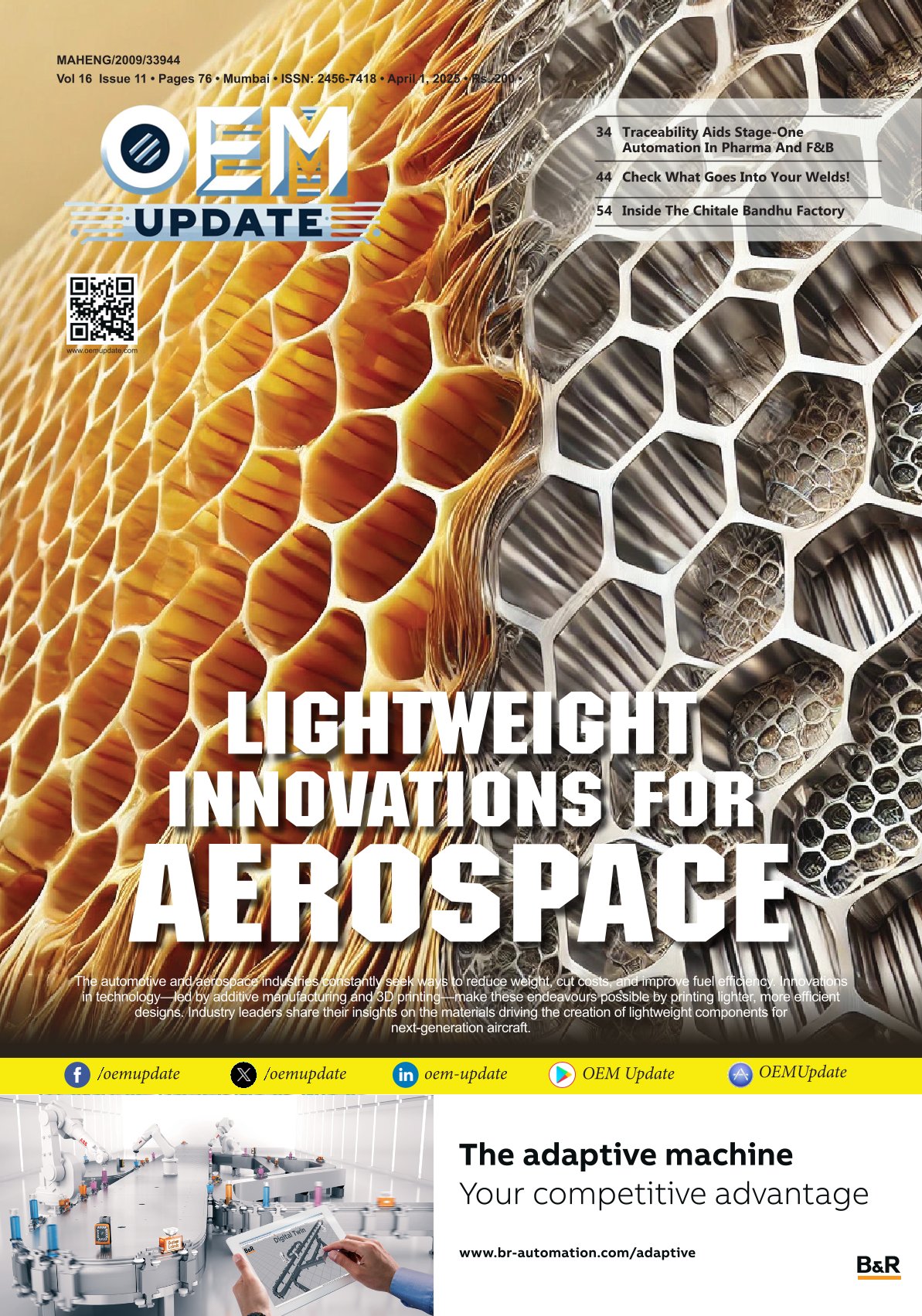Lightweight innovations for aerospace
By Staff Report April 1, 2025 6:16 pm IST
The automotive and aerospace industries constantly seek ways to reduce weight, cut costs, and improve fuel efficiency. Innovations in technology—led by additive manufacturing and 3D printing—make these endeavours possible by printing lighter, more efficient designs. Industry leaders share their insights on the materials driving the creation of lightweight components for next-generation aircraft.
Ever wondered how IndiGo Airlines keeps its fares so low? It’s all about shedding the extra weight—literally! The airline is famous for its all-female crew on certain flights, and this is not a representation issue but because, on average, they weigh 15–20 kg less per person than their male counterparts, saving thousands of litres of fuel annually.
IndiGo also skips the heavy ovens, serving only pre-packaged meals, and ditches glass bottles for paper glasses. The seats are also ultra-light. In 2015, IndiGo lobbied with the aviation regulator to become the first airline to launch an Electronic Flight Bag, reducing 25 kg of paper on its planes by replacing paper charts/manuals with iPads. This reduces weight & reduces their carbon footprint annually by ~2500 tons. Every kilo saved means less fuel burned, lower costs, and cheaper tickets —that’s smart flying!
Less is more—IndiGo Airlines proved this by registering a ₹8,172.4 crore profit in 2024. The lighter the aircraft, the lower the fuel consumption, leading to higher savings and reduced pollution—a win for both business and the environment.
These innovations cannot be adopted by all airlines. Therefore, aircraft and component manufacturers focus on making the entire aircraft lighter to reduce fuel consumption and save costs.
Materials for lightweight
In India, blade manufacturing is on the rise, and there is an increasing demand for microscopy-related analyses, focused on coatings. Multiple coatings are applied to enhance the metal’s ability to withstand high temperatures and meet specific grain requirements. As a result, Indian companies are seeking a deeper understanding of the raw materials and processes involved.
Wings, mechanisms, and turbine systems are designed efficiently for optimal energy yield. The manufacturer manages the shaping operations, ensuring that the design is accurately reproduced during production.
Adimoolam Thirumal, Product Manager – Milling Solutions at EMUGE-FRANKEN India Pvt. Ltd., shares that this process begins in the design stage, where requirements define the initial concepts. We can consider how to work with materials, which involves a thorough evaluation based on previous references and records. This is an ongoing improvement process, including methods of production.
He shares, “Cutting high-strength, heat-resistant superalloy (HRSA) materials to obtain the required shapes and sizes can be challenging. However, with 3D printing, we can develop more effective and efficient methods to reduce weight while adding significant value.
As technology continues to evolve, we are seeing new materials, such as composites, that are more versatile for shaping and production, and that can also be recycled. This could be a game-changer. We must focus on the specifics of each part to ensure they meet the drawing requirements, while also understanding the various intermediate groups, the technologies involved, and the manufacturing challenges we face.”
One of the exciting developments in additive manufacturing is lunar and Martian regolith, or locally available materials on these celestial bodies, for 3D printing. Researchers also focus on functionally graded materials (FGMs), which offer varying properties within a single component. Many universities are making strides in this field, exploring smart materials that can function as sensors and structural components. Additionally, some materials generate electricity when exposed to a magnetic field, further expanding the possibilities when combined with 3D printing innovations. Overall, significant advancements in material science are shaping the future of manufacturing.
Composite materials for aerospace
Composites are crucial in aircraft technology, enabling lighter and more durable nacelles, which house aircraft engines. The nacelle comprises an inlet that ensures laminar flow for better aerodynamic performance. It has a fan cowl that provides access for maintenance on coolers and lines. Although not required by the FAA, a thrust reverser delivers 10% to 30% reverse thrust upon landing and operates at high temperatures (1500-1600°F).
Composites typically can’t withstand temperatures over 250°F without thermal blankets, while titanium and nickel-based superalloys are used in high-temp nacelle sections.
Hardik Someshwar, CEO of AeroDef Nexus, shares a tale of how, in 1990, an aerospace company nearly faced shutdown but was revived by adopting Total Productive Maintenance (TPM) and Lean practices. This pivot led to securing the 787 program, recognised for its advanced composite structures and technologies, including the 787-8, 787-9, and 787-10 variants with significant engine requirements from GE (GEnx) and Rolls-Royce (Trent 1000).
Most aerospace composites are now made from carbon fibre, with sourcing still dominated by Japan, the U.S., and Europe. Southeast Asia, including India, is emerging in the supply chain, with major players like Tata Advanced Systems (TASL) and Hindustan Aeronautics Limited (HAL).
Current challenges include long cycle times, difficulty sourcing raw materials and obtaining aerospace-grade certifications within India. We must enhance our composite production capabilities and establish reliable raw material sources to compete globally. Maintaining high standards in plant operations is essential, with organisations like the National Aerospace Laboratories (NAL) playing a vital role in composite research. For significant advancements, scaling up production is crucial.Additive Manufacturing and 3D Printing
Additive manufacturing allows the processing of materials that are prone to cracking. By utilising electron beam technology and powder-based techniques, working with materials that typically crack when cast becomes feasible. This technology opens up new possibilities for exploring alternative materials. Aerospace leaders such as Boeing and Airbus have conducted detailed studies and life cycle analyses focusing on sustainability. Considering the carbon footprint associated with 3D printing a component is essential while evaluating its entire life cycle.
Akshatha Dayananda, Addwize Leader & Manager at Wipro 3D, shares, “Additively manufactured components are lighter, more complex, and exhibit improved performance. For instance, a turbine blade that previously needed to be replaced after 1,000 hours can now last for up to 3,000 hours. Research and evidence suggest that over the life cycle of these components, they prove to be more sustainable and contribute to fuel savings in the short term. In the long run, significant cost savings can be achieved.”
Different additive manufacturing technologies have varying levels of maturity. Laser powder bed fusion (LPBF) and electron beam powder bed fusion (EB-PBF) are among the most mature. A notable example is GE’s case study on the LEAP fuel nozzle tips—over 100 million of these parts have been manufactured and are currently in service within GE’s LEAP engines. While this achievement isn’t widely discussed, it highlights that thousands, and even millions, of metal components have already been certified and are actively used in aircraft.
Additionally, many components, particularly ducts, are 3D printed in the interiors of civil aircraft. These ducts are designed to maintain laminar flow and ensure easy replacement, making additive manufacturing a practical solution for such applications.
Manoj Sundaram, Head of Business Development, ZEISS India, Industrial Quality Solutions, has observed the production of small flanges and manifolds through additive manufacturing. For example, blades have been manufactured using this technology, achieving weight reductions of 10, 20, or even 30 grams. Over a year, with an aircraft flying approximately 300 times, these weight reductions can significantly impact its carbon footprint. Each gram of weight reduction offers multiple benefits, especially long-term operational efficiency.
While creating lightweight components is relatively straightforward, it is essential to ensure that they meet aerospace industry safety standards. This is where advanced quality systems play a vital role.
When a manifold is produced using additive manufacturing, its quality can be guaranteed by advanced technologies such as X-ray inspection. Even the smallest additively manufactured parts can be qualified through electron microscopy. Lightweight designs through additive manufacturing enhance performance while promoting sustainability and reducing the carbon footprint. Boeing’s noteworthy examples illustrate these advancements.
Breakthrough technologies
The evolution of technology is underway, with advantages and disadvantages to consider. We are witnessing significant progress as the digital world adapts to new concepts. One field is materials science. The focus is on safety factors, and the validation process is critical. If we can shorten the evaluation and validation timelines, it will lead to numerous advancements.
Numerous technologies have been developed for measuring lightweight materials. Additive manufacturing is one approach to achieving lightweight structures, which can be accurately assessed using X-ray computed tomography (CT) technology. Additive manufacturing presents challenges, such as achieving a good surface finish. However, these attributes can be measured non-destructively. Additionally, the concept of digital twins is expanding. Digital twins can measure external surfaces and also assess internal structures. All these technologies allow manufacturers to achieve lighter vehicles while maintaining performance and sustainability, paving the way for a smarter, more fuel-efficient future in aviation.
———————————————————————————–
Manoj Sundaram, Head of Business Development, ZEISS India, Industrial Quality Solutions
“Every gram saved in aerospace lightweight translates into fuel efficiency and reduced carbon footprint. Additive manufacturing, X-ray technology, and digital twins ensure precision, safety, and sustainability in next-generation aircraft manufacturing.”
Adimoolam Thirumal, Product Manager – Millings Solutions, EMUGE-FRANKEN India Pvt. Ltd.
“Aerospace manufacturing is driven by material science, digital adaptation, and additive manufacturing. The challenge lies in balancing innovation with safety, assuring efficient validation, and accelerating the journey from concept to execution.”
Akshatha Dayananda, Addwize Leader & Manager, Wipro 3D
“Additive manufacturing is changing the face of aerospace manufacturing with crack-resistant materials, extended part lifespans, and sustainability benefits. Digital integration, AI-driven monitoring, and traceability ensure precision, reliability, and confidence in every 3D-printed component.”
Hardik Someshwar, CEO, AeroDef Nexus.
“Companies must invest in future technologies and raw material sources, processes, and qualifications to achieve large-scale composites.”
Cookie Consent
We use cookies to personalize your experience. By continuing to visit this website you agree to our Terms & Conditions, Privacy Policy and Cookie Policy.


















